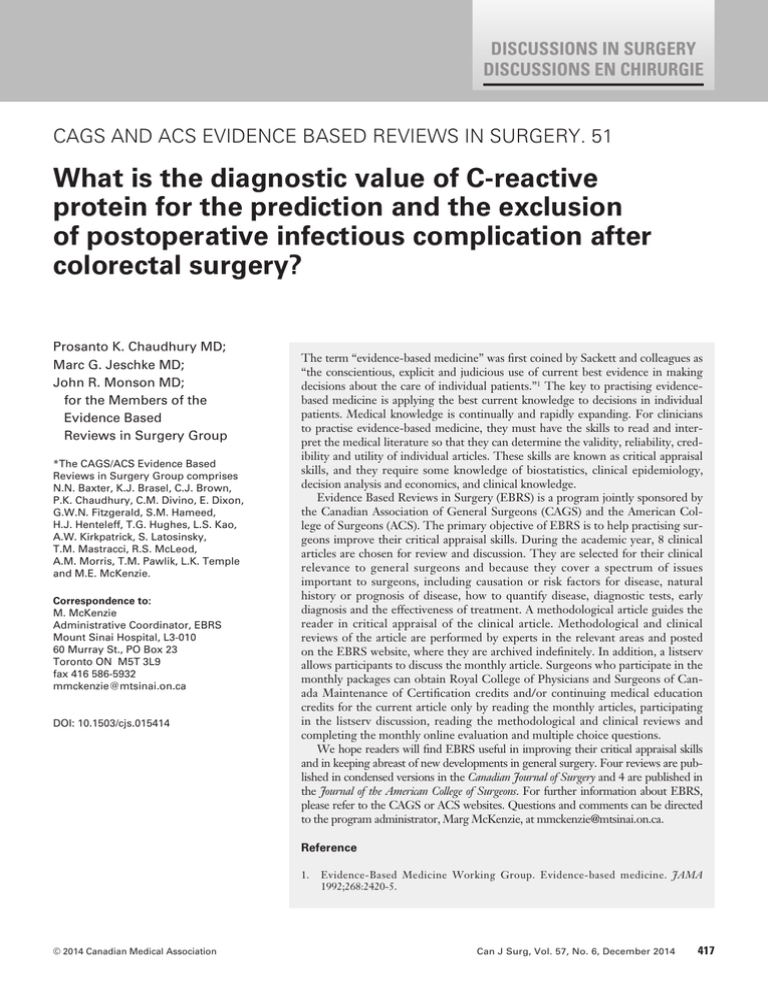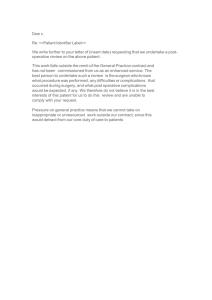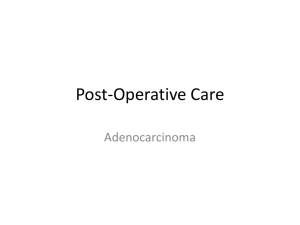What is the diagnostic value of C-reactive protein for the prediction
advertisement

DISCUSSIONS IN SURGERY DISCUSSIONS EN CHIRURGIE CAGS AND ACS EVIDENCE BASED REVIEWS IN SURGERY. 51 What is the diagnostic value of C-reactive protein for the prediction and the exclusion of postoperative infectious complication after colorectal surgery? Prosanto K. Chaudhury MD; Marc G. Jeschke MD; John R. Monson MD; for the Members of the Evidence Based Reviews in Surgery Group *The CAGS/ACS Evidence Based Reviews in Surgery Group comprises N.N. Baxter, K.J. Brasel, C.J. Brown, P.K. Chaudhury, C.M. Divino, E. Dixon, G.W.N. Fitzgerald, S.M. Hameed, H.J. Henteleff, T.G. Hughes, L.S. Kao, A.W. Kirkpatrick, S. Latosinsky, T.M. Mastracci, R.S. McLeod, A.M. Morris,­T.M. Pawlik, L.K. Temple and M.E. McKenzie. Correspondence to: M. McKenzie Administrative Coordinator, EBRS Mount Sinai Hospital, L3-010 60 Murray St., PO Box 23 Toronto ON M5T 3L9 fax 416 586-5932 mmckenzie@mtsinai.on.ca DOI: 10.1503/cjs.015414 The term “evidence-based medicine” was first coined by Sackett and colleagues as “the conscientious, explicit and judicious use of current best evidence in making decisions about the care of individual patients.”1 The key to practising evidencebased medicine is applying the best current knowledge to decisions in individual patients. Medical knowledge is continually and rapidly expanding. For clinicians to practise evidence-based medicine, they must have the skills to read and interpret the medical literature so that they can determine the validity, reliability, credibility and utility of individual articles. These skills are known as critical appraisal skills, and they require some knowledge of biostatistics, clinical epidemiology, decision analysis and economics, and clinical knowledge. Evidence Based Reviews in Surgery (EBRS) is a program jointly sponsored by the Canadian Association of General Surgeons (CAGS) and the American College of Surgeons (ACS). The primary objective of EBRS is to help practising surgeons improve their critical appraisal skills. During the academic year, 8 clinical articles are chosen for review and discussion. They are selected for their clinical relevance to general surgeons and because they cover a spectrum of issues im­port­ant to surgeons, including causation or risk factors for disease, natural hist­ory or prognosis of disease, how to quantify disease, diagnostic tests, early diagnosis and the effectiveness of treatment. A methodological article guides the reader in critical appraisal of the clinical article. Methodological and clinical reviews of the article are performed by experts in the relevant areas and posted on the EBRS website, where they are archived indefinitely. In addition, a listserv allows participants to discuss the monthly article. Surgeons who participate in the monthly packages can obtain Royal College of Physicians and Surgeons of Canada Maintenance of Certification credits and/or continuing medical education credits for the current article only by reading the monthly articles, participating in the listserv discussion, reading the methodological and clinical reviews and completing the monthly online evaluation and multiple choice questions. We hope readers will find EBRS useful in improving their critical appraisal skills and in keeping abreast of new developments in general surgery. Four reviews are published in condensed versions in the Canadian Journal of Surgery and 4 are published in the Journal of the American College of Surgeons. For further information about EBRS, please refer to the CAGS or ACS websites. Questions and comments can be directed to the program administrator, Marg McKenzie, at mmckenzie@mtsinai.on.ca. Reference 1. Evidence-Based Medicine Working Group. Evidence-based medicine. JAMA 1992;268:2420-5. © 2014 Canadian Medical Association Can J Surg, Vol. 57, No. 6, December 2014 417 DISCUSSIONS EN CHIRURGIE Selected article Warschkow R, Beutner U, Steffen T, et al. Safe and early discharge after colorectal surgery due to C-reactive protein. Ann Surg 2012;256:245-50. Key points about the article Objective: To assess the predictive value of C-reactive protein (CRP) level for postoperative infectious complications after colorectal surgery. Data source: PubMed. Study selection: The article included all studies that analyzed the diagnostic accuracy of CRP for predicting postoperative infectious complications after colorectal surgery. Methods: Data on 1832 patients were extracted in­depend­ ently by the same 2 reviewers. Any discrepancies were resolved by discussion. Each reviewer extracted true- and false-positive results and true- and false-negative results; in the 3 studies where this information was not directly available from the publications, the authors were contacted by email to request the data. All of the authors provided the additional information. For 1 study, the authors had access to the raw data. Results: Six studies were identified. The best performance of CRP to predict postoperative infectious complications was on postoperative day 4, on which the mean CRP cutoff value was 135 ± 10 mg/L, the pooled sensitivity was 68% (95% confidence interval [CI] 57%–79%), the specificity was 83% (95% CI 77%– 90%) and the negative predictive value (NPV) was 89% (95% CI 87%–92%). The pooled area under the receiver operating characteristic curve was 0.81 (95% CI 0.73– 0.89). Conclusion: The meta-analysis provides compelling evidence that CRP on postoperative day 4 has a high NPV for infectious complication (89%). Therefore, CRP measurement allows safe and early discharge of selected patients after colorectal surgery. Commentary Postoperative infections remain a common cause of morbidity following colorectal procedures. They may occur in up to 40% of patients. However, in an era of enhanced recovery after surgery (ERAS) and other fast-track protocols, patients are being discharged from hospital within 3–4 days of surgery. There is concern among surgeons that these discharges happen before the infectious complications manifest and may thus lead to a delay in their diagnosis and treatment. The authors argue that this highlights an urgent need for tools to exclude infection before discharge. C-reactive protein was discovered in 1930 and was described as the first acute phase protein. It is produced by the liver, and increases in CRP levels have been used by clin­icians to detect infections or infectious complications. C-reactive protein is a short-acting acute phase protein with a half-life of 16–19 hours and is produced in response 418 o J can chir, Vol. 57, N 6, décembre 2014 to an infectious or stress stimulus. However, despite some properties making it an ideal candidate for infectious complication detection, controversy remains about its use as a predictive marker. The authors have thus performed a systematic review and meta-analysis to assess the diagnostic value of CRP for the prediction and the exclusion of postoperative infectious complications after colorectal surgery. The reporting of this study is based on the “Meta-­ analysis of observational studies in epidemiology” (MOOSE) consensus statement,1 which provides a structure for the reporting of meta-analyses of observational studies. This tool is specific for the meta-analysis of observational studies and has certain differences from the “Preferred reporting items for systematic reviews and metaanalyses,” (PRISMA) which is the most widely accepted tool, and is endorsed by many leading journals. The overall methodologic quality of the study is acceptable. The search strategy is outlined and, although limited to PunMed, reasonably comprehensive. All the included studies were evaluated using a modification of the “Quality assessment of studies of diagnostic accuracy included in systematic reviews” (QUADAS) tool2 — a 6-item checklist. The most recent revision3 of this tool is available at www.bris.ac.uk/quadas/quadas-2/ but was not used by the authors. Studies were not excluded or weighted on the basis of this assessment. The presentation of the results of the assessment is, however, not in keeping with the format suggested by QUADAS. Readers are simply given a numerical score, whereas the suggested format presents a great deal more information that would enable the reader to better understand the strengths and weaknesses of the included studies. Of 296 studies initially evaluated, only 6 studies involving a total of 1832 patients were included in the final analy­sis. There was considerable heterogeneity among the studies. All of them included data on postoperative infectious complications. The rate of infectious complications varied between 11% and 39%, with a pooled estimate of 23.7% (95% CI 16.2%–32.1%). Receiver operating characteristics (ROC) for CRP were plotted for postoperative days 1–5. C-reactive protein with a cutoff value of 135 mg/L performed best as a predictor of postoperative infectious complications on postoperative day 4, as indicated by the greatest area under the curve (AUC). An ROC curve is created by plotting the fraction of true-positive results out of the total actual positive results (true-positive rate [TPR]) versus the fraction of false-­ positive results out of the total actual negative results (false-positive rate [FPR]) for the different possible cut points of a diagnostic test. The TPR is also known as sensitivity. The FPR can be calculated as 1 – specificity. The ROC curve shows the trade-off between sensitivity and specificity. The AUC is a measure of test accuracy. The area measures discrimination — the ability of the test to correctly classify those with and without the disease. An DISCUSSIONS IN SURGERY AUC of 1 represents a perfect test, whereas an AUC of 0.5 represents a worthless one. The AUC of CRP on postoperative day 4 was 0.81, which would be considered reasonably good performance for a diagnostic test. Of historical note, ROC analysis is part of the field of signal detection theory developed during the Second World War for the analysis of radar images. Royal Air Force radar operators needed to decide whether the signals they were viewing represented actual enemy targets, friendly vessels or simply noise. Signal detection theory measures the ability of radar operators to make these decisions. Their ability to do so was called the “radar receiver operator characteristics.” It was not until the 1970s that signal detection theory was applied to the interpretation of medical test results. The best pooled diagnostic odds ratio for CRP was 11.7 (95% CI 6.1–22.3) on postoperative day 4. The odds of patients with a postoperative infectious complication having a CRP value above the threshold were 11.7-fold higher than in patients without infection. Similarly, the NPV of a CRP of 135 mg/L on postoperative day 4 was 89.3% (95% CI 87.1%–91.5%). The evidence presented in the meta-analysis comes from heterogeneous studies of variable methodological quality. There is a strong potential for reporting bias (negative studies of CRP being unlikely to be published). The meta-analysis included only a few studies, and they had small sample sizes, therefore, the effect size may also be prone to bias. The clinicians were also not blinded to CRP results; thus, knowledge of CRP results may have influenced the diagnosis of infectious complications. The authors state, “conversely, if the CRP level on [postoperative day] 4 exceeds this cutoff, the patient must not be discharged and should be followed with clinical examination, laboratory testing, and imaging if necessary to actively confirm or exclude imminent postoperative infectious complications.” Wisely, this statement was not repeated in their conclusion, as the data were by no means strong enough to support it. At best, we can say that CRP levels may be predictive of infectious complications, but that prospective evaluation is required. In the era of ERAS-based care pathways for the management of colorectal surgery patients, the target date for discharge is often postoperative day 3 or 4. The data presented here do not justify delaying discharge to investigate potential complications, but would serve to reassure clinicians that patients with CRP levels less than 135 mg/L are very unlikely to experience postoperative infectious complications after discharge. Competing interests: None declared. References: 1. Stroup DF, Berlin JA, Morton SC, et al. Meta-analysis of observational studies in epidemiology. JAMA 2000;283:2008-12. 2. Whiting P, Rutjes AW, Reitsma JB, et al. The development of ­QUADAS: a tool for the quality assessment of studies of diagnostic accuracy included in systematic reviews. BMC Med Res Methodol 2003;3:25. 3. University of Bristol. QUADAS-2 [website of University of Bristol]. Available: www.bris.ac.uk/quadas/quadas-2/ (accessed Sept. 15, 2014). Can J Surg, Vol. 57, No. 6, December 2014 419

